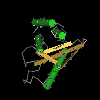?
 
The phosphoinositide binding Phox Homology domain of Sorting Nexin 9 The PX domain is a phosphoinositide (PI) binding module present in many proteins with diverse functions. Sorting nexins (SNXs) make up the largest group among PX domain containing proteins. They are involved in regulating membrane traffic and protein sorting in the endosomal system. The PX domain of SNXs binds PIs and targets the protein to PI-enriched membranes. SNXs differ from each other in PI-binding specificity and affinity, and the presence of other protein-protein interaction domains, which help determine subcellular localization and specific function in the endocytic pathway. SNX9, also known as SH3PX1, is a cytosolic protein that interacts with proteins associated with clathrin-coated pits such as Cdc-42-associated tyrosine kinase 2 (ACK2). It contains an N-terminal Src Homology 3 (SH3) domain, a PX domain, and a C-terminal Bin/Amphiphysin/Rvs (BAR) domain, which detects membrane curvature. The PX-BAR structural unit helps determine specific membrane localization. Through its SH3 domain, SNX9 binds class I polyproline sequences found in dynamin 1/2 and the WASP/N-WASP actin regulators. SNX9 is localized to plasma membrane endocytic sites and acts primarily in clathrin-mediated endocytosis. Its array of interacting partners suggests that SNX9 functions at the interface between endocytosis and actin cytoskeletal organization. |
